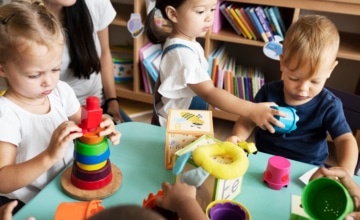Young children receive many messages about what boys and girls should look like and how they should act–from their families and the bigger world in which they live. What can parents do to help children develop a positive and confident sense of who they are? Here are some ideas to guide your action.
THE BASICS
Gender (Who am I?) Around the age of two, most children begin to notice physical differences between boys and girls. At first, their definitions of “boys” and “girls” are hazy at best. Just as they might claim that any animal with four legs is a doggie, they may believe that any person who wears a blue shirt and has short hair is a boy. These understandings change over time.
Most kids begin to strongly identify with a gender around age 3, whether they are cisgender (when their biological sex matches their identity), transgender (when their biological sex does not match their identity), or somewhere in between.
It’s very common for young children to try on different roles, pretending to be a princess one day and a prince the next. What is different for transgender children? Trans kids are likely to be “persistent, consistent, and insistent”—clear and certain that they’re not the gender those around them think they are. Recent research suggests about 1 in every 100 adults in the U.S. identifies as transgender. If you have questions, your child’s health care provider is a good place to start.
Sexual Orientation (Who am I attracted to?) Sexual orientation—a person’s attraction to the same or opposite sex, or both—doesn’t emerge until closer to puberty. Gender identity and sexual orientation are two different aspects of a child’s identity.
SUPPORTING HEALTHY DEVELOPMENT
Make sure your child knows they have your support. Gender identity is a central part of a child’s identity and well-being. Parents don’t make their children cisgender or transgender. This is also not a choice children make—it is simply who they are. To grow up healthy, every child needs to know that they are fully accepted, loved, and supported.
Be aware that gender stereotypes may start even before your baby is born. Often gender stereotypes start early–maybe at your baby shower with a joke about how unprepared fathers are for diaper changing. (Spoiler: Dads do just fine.) Or you may receive a flurry of pink and frilly baby clothes for your daughter. It’s ok to choose neutral clothing colors and styles for children. And of course, take their preferences into account as they grow.
It’s also a good idea to offer children a range of toys and experiences, including toys that some may think cross gender lines (like a doll for a boy or a train set for a girl).
Be clear about your family’s values: “In our family, anyone can play with any toy. It doesn’t matter what your gender is.” You can help your child develop an inclusive worldview by answering their questions matter-of-factly. “Jason has two parents who love him very much, just like you. He has two dads. You have a mom and a dad.”
As children grow, apply a gender-neutral approach to daily chores and family responsibilities. For example, teach all children to help with dinner and laundry, wash the car, and rake leaves. Diverse experiences help children learn more about themselves and develop a broader worldview.
Read stories that feature all kinds of families, as well as stories that include transgender, non-binary, and gender expansive characters. Shared reading is a powerful way for all families to nurture an inclusive worldview and challenge stereotypes from the start. You can find suggested titles here and here.
Build an inclusive community. This is important for all kids, and it’s especially important for kids who may later identify as LGBTQ. In the past, one of the toughest things for kids discovering that their sexual orientation or gender identity was different than those around them was a feeling of being alone. Actors, politicians, teachers, sports stars, family, and friends who are upfront about their identities help make the world more comfortable for questioning kids. Make it clear that all people are welcome in your community and in your household. Living your values in this way shows your child that they will be loved however they show up and whoever they become.
For more information:
- Sexual Health and Safety
- How do I talk with my child about identity?
- Information for parents on all issues related to gender identity
- Information for LGBTQ+ people, parents, families, and allies
This article is part of a series on Parenting for Social Justice. For more, visit zerotothree.org/parentingforsocialjustice



